wxnut
TPF Noob!
- Joined
- Sep 9, 2004
- Messages
- 594
- Reaction score
- 7
- Location
- Wisconsin
- Website
- www.dougraflikphotography.com
Why does my camera shoot at 72 DPI when I shoot on the Hi REs JPG setting and makes the file 60 inches by 40 inches, but when I shoot at RAW it opens up at 300 DPI and a file size of 14.5 inches by 9.7 inches?
Doug
Doug


![[No title]](/data/xfmg/thumbnail/34/34145-b89ccc67a24004d6d7a9026a7395914b.jpg?1619736318)
![[No title]](/data/xfmg/thumbnail/34/34142-948c6bafdf60862125009004d5a06e46.jpg?1619736315)

![[No title]](/data/xfmg/thumbnail/30/30884-b92cca2d3ad6f728825cf7e936e8cef6.jpg?1619734496)


![[No title]](/data/xfmg/thumbnail/30/30883-04222f7ae234efdf80dff6f96ddad16f.jpg?1619734495)


